When the scale and importance of the Cambrian explosion was realized, it confronted evolutionists with a major puzzle. The February 1999 edition of the famous scientific journal Trends in Genetics (TIG) admitted that the Burgess Shale fossils could not be explained in terms of the theory of evolution:
It might seem odd that fossils from one small locality, no matter how exciting, should lie at the center of a fierce debate about such broad issues in evolutionary biology. The reason is that animals burst into the fossil record in astonishing profusion during the Cambrian, seemingly from nowhere. Increasingly precise radiometric dating and new fossil discoveries have only sharpened the suddenness and scope of this biological revolution. The magnitude of this change in Earth’s biota demands an explanation. Although many hypotheses have been proposed, the general consensus is that none is wholly convincing [emphasis added]127
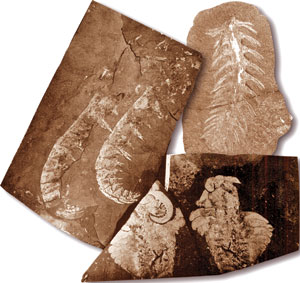
Some Burgess Shale fossils. Supporters of evolution began producing unrealistic theories to account for the existence of these highly specialized organisms.
The organisms that appear in Cambrian strata, and the research into them by scientists, clearly reveal in every detail that no process of evolution ever took place. This fact led to terrible panic among all evolutionists, Darwin included, and obliged them to review all the claims they had made so far.
Some Darwinists who hadn’t expected this sudden appearance in the Cambrian Period began to doubt the very theory they had advocated. Others attempted to keep alive the theory, which had now been definitively repudiated by the evidence. As the result of these endeavors, they produced highly exaggerated and nonsensical theories, totally inconsistent and all very different from one another, based on no scientific evidence, and incompatible with logic and reason. Their objective was to be able to introduce some factor of evolution into the Cambrian explosion, which they had ignored for many years but which the overwhelming weight of the evidence had finally forced them to accept.
Dr. Raymond G. Bohlin, a scientist and an expert in the fields of zoology, population genetics, and molecular and cellular biology—and who espouses creation—describes these astonishing and fruitless efforts:
So, where is the documentation for the long history of the evolution of these creatures? The usual answer is that the necessary fossil layers prior to the Cambrian period have not been discovered yet. The fossils are just missing! How convenient! This, after all, was Darwin’s excuse and many evolutionists after him followed suit. Well, recent discoveries from Canada, Greenland, China, Siberia, and Namibia document quite clearly that this period of biological creativity occurred in a geological instant virtually all around the globe. So, the usual excuse no longer holds water. While evolutionists are not exactly joining a creationist wave of conversion, they are being forced to ask tough questions concerning the nature of evolutionary change . . . Darwinism has always been characterized by slow gradual change that is imperceptible in our time frame. Major evolutionary change was only visible as we looked to the fossils to reveal the number and type of intermediates between species and major groups. But the Cambrian explosion is anything but gradual, and identifiable intermediates are totally absent [emphasis added].128

Dr. Ray Bohlin
In fact, evolutionists did express all the imaginary probabilities regarding this subject. But in producing their theories, they were making a grave mistake by allowing no possibility that these creatures had never evolved. (Or they may have recognized that possibility, but were reluctant to accept it.) They did not consider that these creatures were created, brought into being at that moment at Allah’s command. They were unable to see that Allah, Who creates all things in a flawless manner and order, also created complexity and order in these arthropods’ system. They failed to calculate that systems too perfect to permit any other explanation and too ordered to permit any debate had actually been created.
However, Allah revealed this in the Qur’an, sent down by Him 1,400 years ago:
He is Allah—the Creator, the Maker, the Giver of Form. To Him belong the Most Beautiful Names. Everything in the heavens and Earth glorifies Him. He is the Almighty, the All-Wise. (Surat al-Hashr, 24)
The theories put forward in order to provide an evolutionary explanation of the Cambrian explosion were actually objections to the fact of creation. The reason we are examining these theories here is to demonstrate the difficult position evolutionists are in regarding this great marvel of creation, and to describe how they lack any other answers. It is to show how nonsensical is the theory they developed. As ever, evolutionists once again reveal that in the face of Allah’s flawless creation, they are facing a complete dead-end.
No matter how much they may strive, evolutionists will always confront the fact that Allah has created the universe and all living things. And since there is constant perfection in the order that Allah has established, their scientific findings will always refute all explanations opposed to this fact. Their theories will always remain groundless and unsupported and, like all the theories produced for the purpose of keeping the theory of evolution alive, they too will inevitably be refuted.
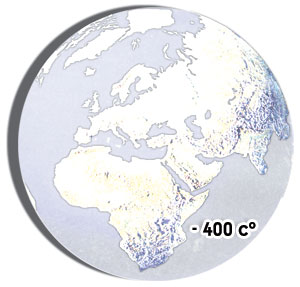 This conjectural theory is like a cloak used to conceal the irreparable damage inflicted on the theory of evolution by the Cambrian explosion and to distract attention away from it.
This conjectural theory is like a cloak used to conceal the irreparable damage inflicted on the theory of evolution by the Cambrian explosion and to distract attention away from it.
Basically, the hypothesis maintains that the Earth experienced intense ice ages during very early geological periods. Scientists supporting this hypothesis claim that between 750 and 590 million years ago, there were a number of ice ages, each lasting up to 10 million years. During these periods, glaciers up to 1 kilometer (0.621 mile) thick descended as far as the equator, turning the Earth into a ball coated with ice.
This hypothesis, which has been debated since the 1960s, was once again raised by the Harvard University geologist Paul F. Hoffman and Daniel P. Schrag in the 1990s. According to this claim, in the pre-Cambrian, the entire world, without exception—from the Poles to the equator—was covered in a layer of ice. The average surface temperature on Earth was -40 degrees Celsius (-40 degrees Fahrenheit). Again according to this hypothesis, the last of these ice ages lasted for 10 to 20 million years.
The claim that evolutionists use to cloak for the supposed evolutionary appearance of species in the Cambrian Period lies basically in what came next. They suggest that at the end of this ice age, a sudden global warming took place and all the ice melted. Life forms that had existed before the Earth entered this glacial period consisted of single-celled organisms. Afterwards, in some way, matchless, perfect and complex multi-celled organisms evolved among the melting ice caps!
Of course, it is easy to come up with fairy tales. On one evolutionist website, for instance, this allegedly scientific theory is described as follows:
And when that ice started melting in the heat, models show the melting process would have been rapid, taking perhaps as little as 100 years to complete the process. As the heat worked into the ocean, it would have produced hyper-hurricanes and enormous mega-typhoons, unlike anything we see today in scope and severity. The weather would have gone crazy. Storms could have lasted for centuries. Photosynthetic cyano-bacteria rapidly radiated into the now vast swaths of open water and into new coastal shallows which were free of thick ice, and carried the entire ecosystem along with it, producing a burst of evolutionary adaptation we see in the record as the Cambrian Explosion.129
The supposed freeze proposed in the snowball Earth hypothesis caused great excitement among evolutionist scientists, although they were all aware that it was only a hypothesis. Even if such severe freezing did take place, there could have been no possible thaw from it. The freezing’s aftereffects would have left the Earth a barren planet for all eternity. All life would have been eliminated, and it would have been impossible for new species, human beings included, to develop. An article by Kevin Peterson of Dartmouth University in New Hampshire in the 12 April, 2003, edition of New Scientist magazine tackled the question of whether bacteria or algae could have survived in such a great freeze:
I don’t say it’s impossible. You never say “impossible” when you’re talking about life, because there are always some bacteria out there that will prove you wrong. But it’s highly unlikely. You just can’t freeze the whole world over and expect life to survive it [emphasis added].130
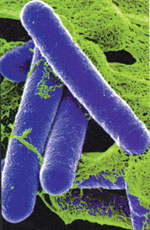
“You never say ‘impossible’ when you’re talking about life, because there are always some bacteria out there that will prove you wrong. But it’s highly unlikely. You just can’t freeze the whole world over and expect life to survive it.”
The words “a burst of evolutionary adaptation” are actually completely empty. There is no scientific basis for linking changing climatic conditions with the scenario of a transition from single-celled to multi-celled organisms. For that reason, evolutionists have never touched on which fictitious evolutionary mechanisms might have entered the equation to give rise to 50 entirely different phyla.
7 How, for instance, did melting glaciers add new genetic information to the DNA of single-celled organisms? What climatic factors could have endowed the DNA of a single-celled organism with new genetic information for such complex organs as eyes, limbs and antennae? What experimental evidence supports such a scenario? For example, have bacteria kept at very low temperatures in laboratory conditions ever been observed to acquire new genes and develop into multi-celled organisms?
Evolutionists cannot answer these questions, which is why they try to gloss over the subject with far-fetched explanations such as “It happened somehow. Much more complex life forms suddenly evolved as climatic conditions improved.”

“Snowball Earth” is one of the hypotheses proposed in order to account for the sudden variety of life on Earth in evolutionary terms. According to this hypothesis, ice ages each lasting some 10 million years occurred during an interval between 750 and 590 million years ago. Glaciers, up to 1 kilometer (0.621 mile) thick allegedly reached as far as the equator and turned the Earth into a snowball. It is then alleged that at the end of these ice ages, sudden global warming took place and all the ice melted. This sudden change somehow led to the emergence of very different life forms. This hypothesis, which provides no scientific evidence for how living things came into being and which is full of countless impossibilities, exhibits a great time difference with the Cambrian explosion. Evolutionists are still unable to account for the supposed evolution.
There is no cause-and-effect relationship between the Snowball Earth hypothesis and the Cambrian explosion, merely a chronological link between the two. The explosion took place after—as evolutionists claim—the hypothetical ice ages ended.
In short, any attempt to link the Snowball Earth hypothesis and the origin of multi-celled organisms has no scientific foundation. Evolutionist advocates of the hypothesis are following an empty belief. This article on the subject, published on the BBC’s website, is an indication:
There are some tantalising geological clues that show this theory may be true but the problem is, the clues and the Snowball Earth theory defy the laws of nature.131

If, as the Snowball Earth theoreticians claim, there had been such a freeze on Earth, then there could have been no return from it. This freezing effect would have left the Earth barren for all eternity. Life forms that had not previously existed could not have suddenly emerged as the result of supposed evolution...
It is of course irrational to accept so-called clues opposed to the laws of nature and to subscribe to the Snowball Earth hypothesis. The rational response is to recognize that this theory is bereft of any scientific foundation and is supported for ideological reasons alone; and to accept that the true origin of living things is Allah’s flawless creation.
Gabrielle Walker is a Princeton University science writer and an adherent of evolution. She sought to muster support for the hypothesis in her book Snowball Earth. In an article she wrote for New Scientist, she said the following:
Not a single alternative theory exists to explain one of the most dramatic evolutionary innovations—the leap from single to multicellular organisms. . . . The problem for the Snowball idea is that this explosion happened around 545 million years ago, a good 45 million years after the Snowballs ended. That’s far too long to sit around with a lighted fuse, waiting for the bang. Even Paul [Hoffman] admits this.132
Time is not the only problem, of course. Andrew Parker of the Oxford University Zoology Department declares the invalidity of the Snowball Earth hypothesis in his book In the Blink of an Eye:
[This idea] assumes the course of evolution was predetermined from the beginning. We are given a situation where the Precambrian worm-like bodies of all animal phyla are just itching to take on their Cambrian forms, but ice puts everything on hold. Then, when the ice has gone, it is time for evolution again. This is not an objective view. As we have considered before, why should a convenient worm shape have to change? If the course of evolution was predetermined, why did it not continue in the water under the ice? The second major doubt cast over this laboured explanation for the why of the Cambrian explosion is that the figures simply do not balance. The Cambrian explosion took place between 543 and 538 million years ago. The last Snowball Earth event ended 575 million years ago at the latest. So there is a difference of at least 32 million years between these two events. This is fact. So a Precambrian Snowball Earth event cannot explain the Cambrian explosion, although it could have played a role in the Precambrian “surge.”133
Despite his being an evolutionist, Parker’s words clearly demonstrate the contradictions and logical flaws in the Snowball claim, emphasizing with considerable detail that it is inconsistent in many regards. In fact, many evolutionists have now accepted the Snowball Earth hypothesis as invalid.
To resolve the many uncertainties of that hypothesis, a new theory was put forward. Certain evolutionists regarded the oxygen theory as a lifebelt in order to account for the imaginary evolutionary origin of life.
Complex life forms need to convert food into energy by various ways and means, and aerobic respiration, which requires oxygen, is one of the best and most efficient. Therefore, evolutionists had to include oxygen in some way in their fictitious Snowball Earth hypothesis. They thus came up with the following scenario: For millions of years, life would have been restricted to a few small refuges so nutrients would have accumulated in the oceans, turning them into a tasty chemical soup. As soon as the ice receded, the oceans would have become green with massive colonies of bacteria and algae, which may have injected a pulse of oxygen into the post-Snowball oceans.134
This theory, again based on no scientific evidence, consists, as can be seen from the above account, of a fairy tale. There is absolutely no evidence of any sudden increase in oxygen in the period concerned.
Dr. Paul Chien of the San Francisco University Biology department, who is well known for his research into Cambrian life forms in the Chengjiang formation in China, said this:
The first idea put out was the oxygen theory. They say that maybe in Cambrian times, the oxygen level in the atmosphere and in the oceans suddenly arose to a critical level which could support larger-sized animals. That theory is pretty much shut down because there should be geological evidence for a sudden increase in oxygen [emphasis added].135
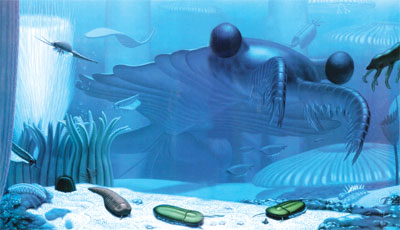 The lack of evidence of any sudden increase in oxygen is, of course, a major problem for the theory. Yet for the evolutionists who advance this theory, the real problem is whether a sudden rise in oxygen could bring living things into existence from nothing. In order for an organism to form and survive, a great many conditions need to be met at the molecular level. All the countless balances essential for life on Earth have to be just right.
The lack of evidence of any sudden increase in oxygen is, of course, a major problem for the theory. Yet for the evolutionists who advance this theory, the real problem is whether a sudden rise in oxygen could bring living things into existence from nothing. In order for an organism to form and survive, a great many conditions need to be met at the molecular level. All the countless balances essential for life on Earth have to be just right.
In addition, all of these conditions must be met at one and the same time. The presence of oxygen is only one of millions of conditions essential to the survival of living things, and is certainly not sufficient on its own. The Darwinists who make such a claim need to answer how the countless amino acids and, a single protein in a living cell, came together in the correct order, how they were copied in the DNA in the absence of enzymes, how the cell acquired a variety of complex functions, and many other such questions.
Darwinists are well aware that oxygen alone has no meaning in the sudden emergence of a complex life form and for the full and perfect survival of complex systems. How were the other necessary conditions met by way of alleged evolution? Darwinists have no answers.
Even if, during the history of the Earth, oxygen did appear in the quantities and at the time hoped for by evolutionists, this would still avail nothing. Even if all the possibilities for life are established, even if all the elements comprising the basis of life—amino acids included, are brought together—even if oxygen is added in the desired amounts, this will still contribute nothing to the development of life. Such conditions will be unable to produce a single protein, and will be unable to turn one pre-existing cell into another. Therefore, the evolutionist claim that there was a sudden change of gasses at one point in the Earth’s history is an empty explanation, yet another technique they employ to gain time and keep people’s attention occupied.
Those who lack sufficient information on the subject may believe that a sudden rise in oxygen levels was sufficient to bring about a greater variety of life forms. Yet Darwinists should not forget one important point: The more people are made aware of the scientific facts, the less effective such tactics are. People now see that all living things are the matchless works of Almighty Allah, and this is confirmed every passing day by the scientific facts. And evolutionists must know that this awareness is increasing rapidly all the time.
Some evolutionists were quick to see the invalidity of Darwin’s claim of fossils as yet undiscovered in pre-Cambrian strata. They had to admit that nothing could be achieved by means of the natural selection that Darwin had proposed as evolution’s fundamental mechanism. However, this meant that evolutionists had to explain, using their own assumptions, the origins of Cambrian life forms that fundamentally refuted evolution. Therefore, they came up with another claim, based on no evidence but on a complete lack thereof.
This theory accepted the hopeless nature of the gradual evolution model that Darwin had put forward, and proposed an alternative to it—neo-Darwinism, otherwise known as the modern evolutionary synthesis.
In 1941, a group of scientists at a meeting organized by the Geological Society of America sought a way to reconcile Darwinian logic with genetic science. The result of lengthy debates among geneticists like G. Ledyard Stebbins and Theodosius Dobzhansky, zoologists like Ernst Mayr and Julian Huxley, and paleontologists like George Gaylord Simpson and Glen L. Jepsen was to use the concept of mutation, proposed by the Dutch botanist Hugo de Vries at the beginning of the century, against the genetic stability revealed by genetic laws.
Mutations are defects occurring in the hereditary mechanisms of living things due to such external influences as radiation.
The scientists gathered at the Geological Society of America gave the answer, “Random mutations,” to the question, “What is the origin of the beneficial changes that develop in living things?”—which question Darwin had attempted to answer on the basis of Lamarck.
The point that these evolutionist scientists either ignored or preferred to ignore was this: It is true that mutations alter organisms’ genetic information, but this change was always a negative one. Mutations do not develop new organs or structures, as evolutionists claim, but typically harm pre-existing tissues. There was no evidence of any benefit produced by a mutation, for which reason all the speculation on mutations’ evolutionary or developmental effect was false. Mutations are usually harmful, and occasionally only neutral events, and this fact by itself is sufficient to invalidate the fictitious mechanisms of evolution as a whole.

Neo-Darwinism is a scenario produced on the basis of the thesis that mutations can be beneficial. However, the science of genetics has never observed a mutation providing any benefit, much less turning one organism into a flawless different species with completely different characteristics. The net effect of mutations is harmful. Therefore, neo-Darwinism rests on no foundation at all, and the idea that mutations constitute the origin of Cambrian life forms is utterly deceptive.
However, this fact did not stop neo-Darwinists. They proposed a scenario in which life developed into the extraordinary complexity we see and know today, and assumed its present perfect appearance by way of random mutations, that were generally beneficial, and all from an original single cell. They hid behind this explanation, saying that Cambrian life forms, which they had for long been unable to account for and which totally demolished the theory of evolution, had developed by undergoing an infinite number of mutations.
First of all, the lengths of time regarded as necessary for the mechanisms employed by the neo-Darwinists to account for the origin of species are very long. Neo-Darwinism maintains that small changes have accumulated in the gene sequences of organisms as the result of random mutations, and that after generations, these accumulated changes eventually led to entirely new species. But as we’ve seen, the fact that mutations do not improve an organism’s genetic information invalidates this claim right from the start.
However, even if for the sake of argument we accept the entirely speculative claim that mutations could have an evolutionary effect, evolutionists are still in a hopeless position in the face of the Cambrian explosion. It is totally impossible for the life forms that appeared in the Cambrian to have developed through such minute incremental changes in such a short time. This illogical claim, devoid of any evidence, does nothing for the supposed evolution of the variety of incomparable species that appeared in the Cambrian.
Yet moreover, the modern synthesis’ own claim that organisms evolved into complex life forms by always adding positive new features invalidates the theory itself. The Neo-Darwinist scenario was dreamed up on the basis of the idea that mutations can be beneficial. The science of genetics, however, has never observed a mutation turning one organism into another with largely different but still flawless characteristics. In fact, there is not even a single example of a mutation benefiting or developing any single cell. For that reason, the theory is based on no grounds whatsoever, and the invalidity of the theory has eliminated its claim regarding Cambrian life forms.
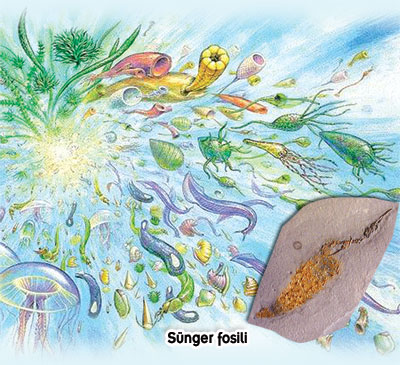
The appearance of Cambrian life forms ushered in the sudden appearance of an amazing cellular variety. Even sponges that appeared in the pre-Cambrian had five different types of cell. The far more complex life forms in the Cambrian definitely possessed many more. Neo-Darwinists cannot explain this amazing variety that appeared in the Cambrian, and are unable to account for even one of these cell types.
The worst impasse facing neo-Darwinism with regard to Cambrian life forms is the great cellular variety that suddenly emerged. Studies on present-day organisms reveal that the sponges that appeared in the pre-Cambrian would have required five different types of cell.136Accordingly, the even more complex life forms that appeared in the Cambrian must have possessed even greater number and variety of cells, because the different characteristics and functions in organisms always require the different functions of different cell types. New proteins also need new genetic information. Neo-Darwinism has to account for the formation of each one of these new cell types and proteins that appeared.
As we have seen earlier in the book, in order to maintain life, the minimally complex single-celled organism requires between 318 to 562 kilobase pairs of DNA. More complex single-celled organisms require 1 million base pairs. Therefore, ever-increasing coding instructions are needed for the production of the proteins necessary to give rise to any arthropod as complex as the trilobite.For example, the fruit fly Drosophila melanogaster, a present-day arthropod, requires around 180 million base pairs of DNA. For a single cell to develop into a colony requires a very serious increase in cellular variety and an enormous, error-free genetic variety.137
In order for multi-celled organisms to emerge from a single cell, therefore, enormous increases in specified genetic information are needed. At the same time, proteins—the product of the genes—must be arranged into high levels of organization. New types of cell require new proteins, which have to be organized into new systems within the cell. And these new cell types must be arranged into new tissues, organs and body systems, which, in turn, must be organized to form body plans and give rise to an organism—a trilobite, an elephant or a human being. Different components with different functions must be organized in the most perfect manner if that organism is to survive, much less thrive. For that reason, each of the new life forms that evolutionists expect to have appeared in these stages in the Cambrian must have exhibited a hierarchical organization in all respects, from the smallest component to all their fully functional features. An extraordinarily superior, functional and specified arrangement of all components must occur.
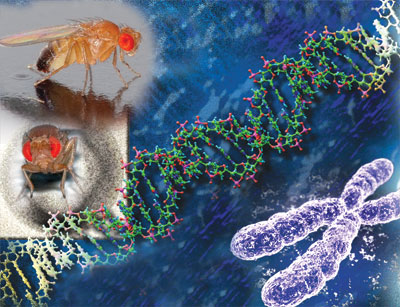
An organism’s transition from a single cell to many means the formation of a vast amount of specified genetic information. New proteins must be arranged into new cells, and new cell types into new tissues, organs and body systems. Darwinists, however, cannot explain the chance formation of even a single protein.
The appearance of multi-celled Cambrian life forms represents a problem for neo-Darwinists, who cannot explain any positive changes, functional differentiation and perfect organization of structure and functions in a single cell. Every detail of the complex body plans that emerged in the Cambrian explosion requires a separate explanation, but neo-Darwinists have no scientific explanation for any of them.
Stephen C. Meyer, who earned his Ph.D. in the History and Philosophy of Science from Cambridge University, sets out the emptiness and failure of neo-Darwinist claims:
In the second scenario, neo-Darwinists envisioned novel genes and proteins arising by numerous successive mutations in the preexisting genetic text that codes for proteins. To adapt Dawkins’s metaphor, this scenario envisions gradually climbing down one functional peak and then ascending another. Yet mutagenesis experiments again suggest a difficulty. Recent experiments show that, even when exploring a region of sequence space populated by proteins of a single fold and function, most multiple-position changes quickly lead to loss of function. Yet to turn one protein into another with a completely novel structure and function requires specified changes at many sites. Indeed, the number of changes necessary to produce a new protein greatly exceeds the number of changes that will typically produce functional losses. Given this, the probability of escaping total functional loss during a random search for the changes needed to produce a new function is extremely small—and this probability diminishes exponentially with each additional requisite change. Thus, Axe’s results imply that, in all probability, random searches for novel proteins (through sequence space) will result in functional loss long before any novel functional protein will emerge.138
Experiments performed in the early 1990s revealed that the probability of any short protein consisting of 100 amino acids forming at random is 1 in 1065.139The structures that appeared in the Cambrian require the existence of much more complex functional proteins, resulting from the combination of a much higher number of amino acids. Neo-Darwinists should be able to explain the formation of different proteins shaping the different cell types in all the species within the 50 phyla that appeared. Yet they are unable to account for even a single different cell type.
The evolutionist paleontologist Richard Fortey of London’s Natural History Museum expresses this fact in these words:
Even if evidence for an earlier origin is discovered, it remains a challenge to explain why so many animals should have increased in size and acquired shells within so short a time at the base of the Cambrian.140

Even assuming that these imaginary beneficial mutations did take place, another difficulty arises regarding natural selection—the second supposed evolutionary mechanism proposed by evolutionists. In order for new cell types to be functional, they must be closely coordinated with one another. This requires that all the systems giving rise to an organ must exist in perfect, efficient form at the same moment. According to the theory of evolution, functional advantages will be favored and passed along by the mechanism of natural selection, while non-functional proteins will not. Therefore, any given cell will be eliminated long before it has time to perform its task in a functional manner together with other cells. All this clearly shows that if both mechanisms—mutation and natural selection—are operative, then evolution cannot possibly come about.
The Japanese scientist Susomo Ohno elucidates this with various calculations in the journal Proceedings of the National Academy of Sciences:
Assuming the spontaneous mutation rate to be generous 10-9 per base pair per year and also assuming no negative interference by natural selection, it still takes 10 million years to undergo 1% change in DNA base sequences. It follows that 6-10 million years in the evolutionary time scale is but a blink of an eye. The Cambrian explosion denoting the almost simultaneous emergence of nearly all the extant phyla of the Kingdom Animalia within the time span of 6-10 million years can’t possibly be explained by mutational divergence of individual gene functions.141
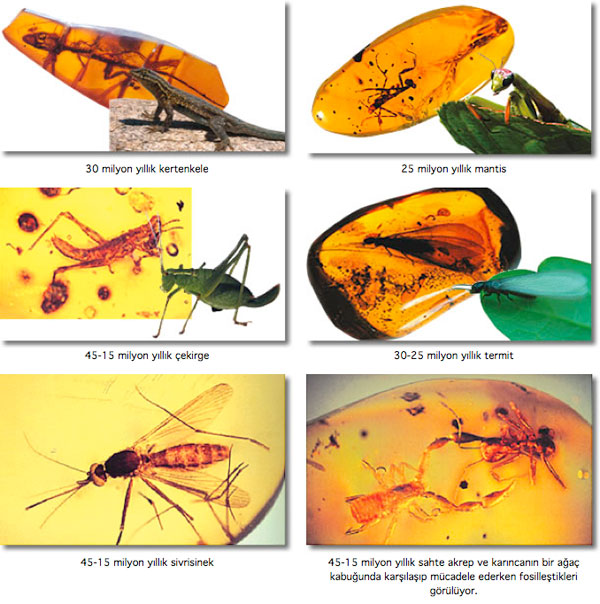
Stasis—in other words, continuity—in the fossil record refutes the gradual model of evolution through mutations foreseen by neo-Darwinism. The remains that many living things left behind in the fossil record millions of years ago are identical to the features of specimens living today. There is no trace of gradualism. The fossil record provides no example of any intermediate forms.
Stasis—in other words, stability in the fossil record—also refutes the gradual-evolution-through-mutations model propagated by neo-Darwinists. Specimens of organisms in the fossil record that existed millions of years ago are identical to their descendants alive today. According to stasis, living things emerge with the traces they have left behind in the fossil record with the same features they possess today or possessed in the recent past. The fossil record shows no intermediate forms and no change over the course of millions of years. This confirms that living things never undergo evolution and also constitutes one of the most serious blows to neo-Darwinism.
The evolutionist Peter G. Williamson, of the Harvard University Geology Department, sets this out in a paper in Nature magazine:
The principal problem is morphological stasis. A theory is only as good as its predictions, and conventional neo-Darwinism, which claims to be a comprehensive explanation of evolutionary process, has failed to predict the widespread long-term morphological stasis now recognized as one of the most striking aspects of the fossil record.142
After admitting that neo-Darwinism is not supported up by the fossil record, Stephen Jay Gould’s description of the theory’s position reads like an obituary notice:
[Neo-Darwinism] is effectively dead, despite its persistence as textbook orthodoxy.143
Neo-Darwinism, or the modern evolutionary synthesis, has been put forward simply to satisfy evolutionist requirements and to excuse their lack of evidence. It is another claim, another fairy tale, invented to account for the Cambrian explosion and keep alive the theory of evolution. In fact, a number of evolutionists are in complete agreement on this.
Dr. David Raup, a University of Chicago paleontologist and an evolutionist, sets out this fact:
“All of the authors of the neo-Darwinian theory which they formulated back in the thirties and forties are losing their influence. ... I predict that that whole concept will be thrown out in the next ten years, and a new theory will be devised to take its place. A new wave of thinking is sweeping the field.”What will be the new theory? Dr. Raup confessed, “I have no idea.”144
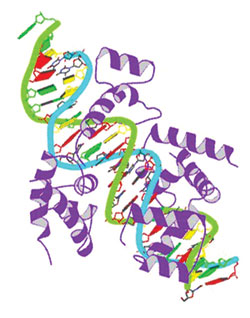 Evolutionists, unable to explain the imaginary evolutionary origin of the Cambrian explosion, realized that the new findings in genetics totally invalidated the claim that life forms so very different to one another could have descended from some common ancestor. They therefore felt the need to adapt their claims to these new discoveries. As a result, the idea of Hox genes was proposed.
Evolutionists, unable to explain the imaginary evolutionary origin of the Cambrian explosion, realized that the new findings in genetics totally invalidated the claim that life forms so very different to one another could have descended from some common ancestor. They therefore felt the need to adapt their claims to these new discoveries. As a result, the idea of Hox genes was proposed.
So-called Hox genes, a particular subgroup of homeobox genes, are a group of genes shared by a number of animal groups. What distinguishes these from other genes is their central task in regulating the body development. Hox genes are managers that control the development of all life, from a fertilized egg cell to maturity, instructing the genes that will construct a particular organ when and where to go into action. For example, the cells that will comprise the spinal cord settle in the region of the back from the moment the embryo first forms. The cells that constitute the eye take their place in the cranial section. This order or placement is encoded in the Hox genes. Instructions issued by the Hox genes are forwarded to an initiator protein with a sequence of 60 amino acids, again produced by Hox genes. This protein binds to and activates the relevant genes. However, Hox genes contain no information about any given organ, the eye for instance. They are merely charged with switching the genes that do bear these data on or off. In short, Hox genes are like buttons that activate or deactivate the gene group concerned with a particular production. For example, the body plan, appearance and development of mammals are controlled by some forty Hox genes.145
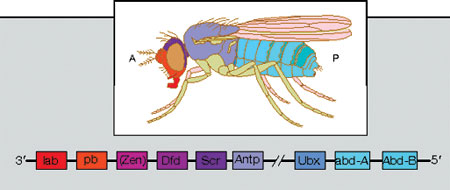
The sequence of Hox genes on the chromosome is the same as the arrangement of those body parts the development of which is regulated by these genes. Changing the location of these genes in the fruit fly Drosophila caused odd-looking insects with legs sticking out of their heads. Thus in complex structures the damaging effects of even a conscious mutation are plain to see. This fact refutes all Darwinist claims on the subject.
One important feature of Hox genes is that they line up on the chromosome in the same sequence as the regions with which they are concerned. For example, if we examine a fly, we see that its body consists of a number of sections: its head, thorax, and abdomen. The first gene in the fly’s Hox gene series is the one that regulates the development of the head. The next one regulates the development of the thorax, and so forth.
When scientists discovered this arrangement, they wondered if they tampered with the sequence of Hox genes in organisms, what the effects would be. To that end, they carried out a number of experimental mutations. Changing the position of these genes in Drosophila fruit flies led to the emergence of monstrous insects, such as those with legs emerging from their heads.146
These results make it clear how complex the genetic codes in living things are, and that any random changes to that complexity will have inevitably harmful effects. The idea that Hox mutations could cause living things to evolve into other species was thus shown to be illusory.
Dr. Christian Schwabe from the Department of Biochemistry and Molecular Biology, Medical University of South Carolina describes these results:
Control genes like homeotic genes may be the target of mutations that would conceivably change phenotypes*, but one must remember that, the more central one makes changes in a complex system, the more severe the peripheral consequences become. . . . Homeotic changes induced in Drosophila [fruitfly] genes have led only to monstrosities, and most experimenters do not expect to see a bee arise from their Drosophila constructs.147As you have seen, the development of any living thing is an exceedingly complex process. The Hox genes that regulate such processes definitively refute scenarios based on random change. Even so, some evolutionists still ignore this scientifically demonstrated fact and continue to defend evolutionary scenarios concerning Hox genes. James Valentine of University of California at Berkeley, David Jablonski from University of Chicago and Douglas Erwin of the National Museum of Natural History in Washington D.C. relate Hox genes to the sudden emergence of Cambrian life forms, suggesting that many phyla that arose in that period differentiated from another as a result of mutations taking place in these Hox genes. In order to protect their scenario from the known harmful effects of Hox mutations, they resort to the entirely artificial claim, based on no scientific observation, that the Hox genes at that time were highly flexible and permitted change.
Simon Conway-Morris of Cambridge University says that this hypothetical “flexibility” rests on no scientific grounds:
Just as spoken language (also modular) is flexible enough to support the whole of human culture, says Valentine, this genetic language is so basic, so powerful, and so adaptable that it could underlie the whole amazing diversity of animal life.
Sounds great, but making bold claims is the easy bit—to convince your colleagues, you usually need some evidence. Valentine, Jablonski and Erwin needed to show that these mapmaking genes actually existed in the Cambrian. That posed a problem— . . . genes don’t fossilise, least of all for half a billion years and more.148
. Raymond G. Bohlin, a zoologist and molecular biologist, describes the unscientific aspect of the assumption regarding Hox genes in the Cambrian:
Some evolutionists have gone so far as to suggest that the mechanisms of evolution operating in the Cambrian were probably radically different from what has taken place ever since. This raises the possibility that we may never be able to study these mechanisms because animals with the proper genetic structure no longer exist. We are left only with the products of the Cambrian explosion and none of the precursors. The speculations will therefore be wild and uncontrollable since there will be no way to test these theories. Fossils leave no trace of their genetic organization.149
 The absence of Hox genes in the fossil record represents a problem for evolutionists. However, even if they had found the genes in question in fossilized Cambrian life forms, they would still not have overcome this difficulty, because the structure and functions of Hox genes do not support the theory of evolution.
The absence of Hox genes in the fossil record represents a problem for evolutionists. However, even if they had found the genes in question in fossilized Cambrian life forms, they would still not have overcome this difficulty, because the structure and functions of Hox genes do not support the theory of evolution.
These genes control structures that have already been encoded. These genes cannot code for a new structure and cannot endow an organism with any new organ that does not already exist. They don’t produce new genetic information for the development of structures. They are merely regulators. They use the information given to them, and organize it in such a way—by the will and with the permission of Allah—to establish an order within the body. Therefore, they cannot be the cause of the emergence of new information, new structures and new organs needed for a completely different life form.
Dr. Paul Chien, chairman of the Department of Biology at the University of San Francisco, who discovered the Cambrian fauna in the Chinese Chengjiang formation and carried out lengthy research into them, has this to say:
There are other theories, too, like that of Berkeley professor James Valentine . . . In developmental biology, the study of embryo development, there’s been a big discovery of something called Hox genes. They are regulatory genes, and they turn on and off sequences, the development of the eye and so on.
Valentine infers that primitive organisms accumulated enough Hox genes to suddenly make a different body plan. So he’s trying to correlate Cambrian explosion with the development or accumulation of Hox genes. But I think there are many theoretical difficulties he’s facing.
John Wells has the idea that Hox genes won’t do it. He claims that Hox genes are only switches. You can put the switch on different systems and it just turns on and off. You’re not getting new information out of Hox genes.150
Another point that evolutionists are unable to explain is how the first Hox gene could have emerged. Evolutionists maintain that the accumulations formed by Hox genes led to the Cambrian variety, yet they are silent on the subject of how these regulatory genes—with an exceedingly complex structure, perfect sequence and functioning—came into existence. Further, they claim that the different genes that regulate the development of different characteristics evolved from one another, which is a scientific impossibility.

Simon Conway Morris’s book The Crucible of Creation, about Cambrian life forms.
The question of how the first Hox gene, which supposedly constitutes the ancestor of all the rest, emerged by chance still awaits an explanation.
Those who claim that Hox genes had the potential to give rise to a biological Big Bang like the Cambrian explosion must account for why this did not occur yet again, in the subsequent 540 million years of natural history. If Hox genes do pack such potential, then why did species that existed after the Cambrian give rise to no subsequent explosions? And why did other phyla not emerge?
These questions also apply to the present day. Why do present-day scientists not witness such changes? Such observations should constantly be reported in journals such as Nature and Science, yet not a single example has ever been published!
In addition, as you have already seen in the example of the fruit fly, Hox mutations produce defective entities. The theory that Cambrian phyla evolved from earlier single-celled organisms requires countless deformed organisms to bridge the gap. Therefore, if Cambrian phyla did emerge through Hox mutations, where are all the countless intermediate fossils? For example, why are there no trilobite fossils with limbs coming out their heads? Why do living things in the fossil record always display flawless structures?
The theory of evolution has no answers.
In his book, Simon Conway-Morris admits this lack of response:
If we can explain how an animal develops from the fertilized egg through a series of embryonic stages in which features such as segmentation and limbs are formed, then there is a fascinating possibility of applying this knowledge to the Cambrian explosion. Do different animals have very different sets of genetic instructions? If so, how might they have evolved, and were there special mechanisms operating in the Cambrian evolutionary burst that no longer apply today? Is it necessary to hypothesize a set of genetic instructions that were exceptionally labile, that is, unusually flexible, in order to explain the apparent plethora of animal body plans that irrupted in the Cambrian seas? We are still some way from providing definitive answers, but at the moment, and somewhat surprisingly, the answer to all these questions seems to be ‘No.151
Evolutionists’ lack of an answer to how evolutionary development could be supposedly brought about with Hox genes clearly demonstrates that this scenario is completely invalid and consists merely of blind hope. The idea that Hox genes caused the evolution and variety of Cambrian life forms is totally unscientific and completely speculative. An article titled “When Life Exploded” in Time magazine dealt with the Cambrian explosion, and clearly stated that the evolutionist claim regarding the Hox gene is a fantasy:
Of course, understanding what made the Cambrian explosion possible doesn’t address the larger question of what made it happen so fast. Here scientists delicately slide across data—thin ice, suggesting scenarios that are based on intuition rather than solid evidence [emphasis added].152
Every theory put forward regarding how Cambrian life forms emerged is an assumption, a story that evolutionists wish had actually happened. Evolutionists are perfectly aware that scientifically, there is no possibility of this actually having happened, but they refuse to abandon their claims, and when one becomes untenable, they produce another.
A powerful imagination is no challenge for evolutionists. They have invented a whole history of life on Earth, and have no qualms about making up new details within that scenario. However, no matter what they do, still there are still Cambrian life forms they cannot explain.
In one verse Allah tells us:
They plotted and Allah plotted. But Allah is the best of plotters. (Surah Al ‘Imran, 54)
Deniers are unaware of the truth revealed in this verse. Those who deny Allah, who persist in striving against Him, are unaware that they will be confronted by His plot. Since they refuse to believe that Allah has created all things, they are unable to understand that all things on the Earth and in the heavens—and everything they do themselves—is under His control.
Those who oppose Him fail to comprehend in what ways Allah’s flawless creation will appear before them. They fail to see and understand that all claims brought up in opposition to Allah are invalid right from the outset. For that reason, their efforts to keep on producing theories in opposition to the fact of creation are empty. They turn down a road where they can never obtain any results and spend their lives to that end.
Yet it is Allah Who created them as well as the Cambrian life forms of 530 million years ago, and Allah sees and knows their every deed. We are told in one verse that they will be rewarded for all these deeds in the Hereafter:
Everything in the heavens and the Earth belongs to Allah. He knows what you are engaged upon. On the Day when they are returned to Him, He will inform them of what they did. Allah has knowledge of all things. (Surat an-Nur, 64)
| In the creation of the heavens and Earth, and the alternation of the night and day, and the ships which sail the seas to people’s benefit, and the water which Allah sends down from the sky—by which He brings the Earth to life when it was dead and scatters about in it creatures of every kind–and the varying direction of the winds, and the clouds subservient between heaven and Earth, there are Signs for people who use their intellect. (Surat al-Baqara, 164) |
127- Gregory A. Wray, “The Grand Scheme of Life”, Review of The Crucible Creation: The Burgess Shale and the Rise of Animals by Simon Conway Morris, Trends in Genetics, Şubat 1999, vol 15, no. 2![]()
128- http://www.leaderu.com/orgs/probe/docs/bigbang.html![]()
129- Steven Darksyde, The Cambrian Explosion And Creationism, http://politics.h umanbeams.com/p405darksyde-cambrianexplosion.php ![]()
130- http://www.newscientist.com/article.ns?id=mg17823904.500![]()
131- BBC Science and Nature, Horizon: Snowball Earth, http://www.bbc.co.uk/science/horizon/2000/snowballearth.shtml ![]()
132- http://www.newscientist.com/article.ns?id=mg17823904.500 - Snowball Earth, Gabrielle Walker, Crown Publishers, 2003, s. 203![]()
133- Andrew Parker, In The Blink of an Eye, Perseus Publishing, Nisan 2003, s. 42![]()
134- http://www.newscientist.com/article.ns?id=mg17823904.500![]()
135- http://www.origins.org/articles/chien_explosionoflife.html![]()
136- http://www.discovery.org/scripts/viewDB/ index.php?command=view&id=2177![]()
137- http://www.discovery.org/scripts/viewDB/ index.php?command=view&id=2177![]()
138- http://www.discovery.org/scripts/viewDB/ index.php?command=view&id=2177![]()
139- http://www.discovery.org/scripts/viewDB/ index.php?command=view&id=2177![]()
140- Richard Fortey, “Cambrian Explosion Exploded?”, Science, 20 Temmuz 2001 -http://www.sciencemag.org/cgi/content/full/293/5529/438?maxtoshow=&HITS=
10&hits=10&RESULTFORMAT=&author1=Fortey%2C+Richard&titleabstract=cambrian&searchid=1130628266485_5010&stored_search=&FIRSTINDEX=0&fdate=10/1/1995&tdate=10/31/2005![]()
141- Susumo Ohno, “The notion of the Cambrian pananimalia genome”, Proceedings of the National Academy of Sciences USA 93 (Ağustos 1996): 8475-78 ![]()
142- Peter G. Williamson, "Morphological stasis and developmental constraint: real problems for neo-Darwinism," Nature, vol 294, 19 Kasım 1981, s.214 -http://members.iinet.net.au/~sejones/fsslrc02.html ![]()
143- http://www.arn.org/docs/abstasis.htm![]()
144- Luther Sunderland, Darwin’s Enigma “Ebbing the Tide of Naturalism”, Master Books, 2. Baskı, Mayıs 2002, s. 114![]()
145- http://www.biltek.tubitak.gov.tr/merak_ettikleriniz/index.php?kategori_id=7&soru_id=1088![]()
146- http://www.newscientist.com/article.ns?id=mg15621045.100 ![]()
147- Mini Review: C. Schwabe, 1994. Theoretical limitations of molecular phylogenetics and the evolution of relaxins. Comp. Biochem. Physiol.107B:167–177;
Don Batten, Hox (homeobox) Genes—Evolution’s Saviour?, http://www.answersingenesis.org/docs/4205.asp ![]()
148- http://www.newscientist.com/article.ns?id=mg15621045.100![]()
149- http://www.leaderu.com/orgs/probe/docs/bigbang.html![]()
150- http://www.origins.org/articles/chien_explosionoflife.html![]()
151- Simon Conway Morris, The Crucible Creation The Burgess Shale and the Rise of Animals, Oxford University Press, 1999, s. 148![]()
152- Nash J. Madeleine, "When Life Exploded," Time, 4 Aralık 1995, s. 74 - http://www.leaderu.com/orgs/probe/docs/bigbang.html![]()